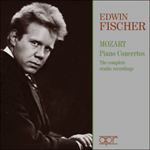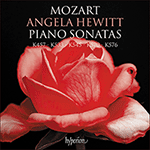
Welcome to Hyperion Records, a British classical label devoted to presenting high-quality recordings of music of all styles and from all periods from the twelfth century to the twenty-first.
Hyperion offers both CDs, and downloads in a number of formats. The site is also available in several languages.
Please use the dropdown buttons to set your preferred options, or use the checkbox to accept the defaults.
The entire work is pervaded by a sense of restlessness full of constantly shifting moods, daring modulations and the exploitation of the complete range of the contemporary piano, with the hands often in widely contrasting registers, a particularly strong colouristic effect on a period instrument. And yet, as Einstein points out, it is structurally coherent, falling into several clear sections, with the second Adagio recalling the first.
While this sense of clearly mapped-out sections—equally evident in the other C minor work here—may owe something to the fantasias of CPE Bach, that is where the similarity ends. In scope and depth of mood Mozart looks far into the future, to Liszt, perhaps even on to Busoni. It is hardly surprising that there were at least three orchestral versions made of K475 early in the nineteenth century, so potent are its colouristic effects.
from notes by Harriet Smith © 2008
L’œuvre déborde d’un sentiment d’agitation permanente, aux climats sans cesse changeants et aux modulations osées exploitant toute l’étendue du piano dont Mozart disposait alors, avec les mains souvent dans des registres contrastés au possible—un effet coloriste particulièrement intense sur un instrument d’époque. Et pourtant, comme le souligne Einstein, l’ensemble demeure structurellement cohérent, découpé en sections nettes, le second Adagio rappelant le premier.
Ce sentiment de sections clairement dessinées—tout aussi patent dans l’autre pièce en ut mineur du présent album—doit peut-être un peu aux fantaisies de C.P.E. Bach. Mais là s’arrête la comparaison car, dans l’envergure comme dans la profondeur de l’atmosphère, Mozart regarde bien plus loin, vers Liszt, voire vers Busoni. Guère surprenant qu’une page aux effets coloristes si puissants ait connu aux moins trois versions orchestrales au début du XIXe siècle.
extrait des notes rédigées par Harriet Smith © 2008
Français: Hypérion
Das gesamte Werk ist von einem Gefühl von Rastlosigkeit und ständig wechselnden Stimmungen durchzogen, sowie kühnen Modulationen und der Nutzung des gesamten Umfangs des zeitgenössischen Klaviers, mit den Händen oft in weit auseinander liegenden Registern—auf einem Instrument der Zeit ein besonders farbiger Effekt. Und dennoch bleibt es, wie Einstein hervorhebt, strukturell kohärent, fällt in mehrere eindeutige Abschnitte, und das zweite Adagio erinnert an das erste.
Während dieses Gefühl eindeutig abgegrenzter Abschnitte—die in dem anderen hier aufgenommenen Werk in c-Moll genauso deutlich sind—den Fantasien von C. Ph. E. Bach etwas verdanken könnte, hört damit aber die Ähnlichkeit schon auf. In seiner Reichweite und Stimmungstiefe blickt Mozart weit in die Zukunft, auf Liszt womöglich sogar Busoni, voraus. Es überrascht also kaum, dass Anfang des 19. Jahrhunderts von K475 mit seinen ausgeprägten, wirkungsvollen Klangfarben mindestens drei Orchesterfassungen angelegt wurden.
aus dem Begleittext von Harriet Smith © 2008
Deutsch: Renate Wendel
 Edwin Fischer - Mozart Piano Concertos Edwin Fischer - Mozart Piano Concertos‘A special contribution that Fischer made to the rehabilitation of Mozart was to revive the practice of performance directed from the keyboard. In thi ...» More |
 Mozart: Piano Sonatas K457, 533, 545, 570 & 576 Mozart: Piano Sonatas K457, 533, 545, 570 & 576With this, the third and final volume of Mozart’s complete piano sonatas, Angela Hewitt completes yet another of her memorable Hyperion series. Of earlier instalments, Gramophone admired the ‘spotless surfaces and impeccable proportions’ of ...» More |

